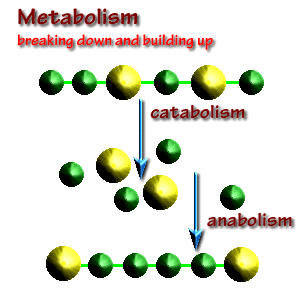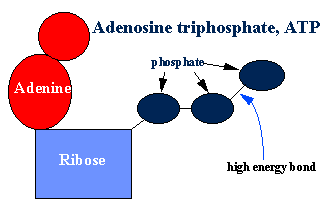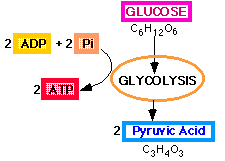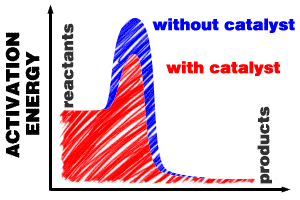Energy Flow in Living Systems
Click on one of the following links to jump to a specific subtopic on this page, or scroll the text up and down to find what you need.Metabolism
Catabolism
Anabolism
ATP Generation
Cellular Respiration
Glycolysis
Citric Acid Cycle
Enzymes
Metabolism is a term applied to the total of all chemical reactions found in living systems. It has two parts: (1) catabolism which are the reactions that break molecules down in to smaller molecules and (2) anabolism by which larger molecules are constructed.

Catabolism usually yields chemical energy and anabolism usually requires chemical energy. In almost all living things, chemical energy is stored in the form of a molecule called ATP (Adenosine Tri-Phosphate). ATP can be converted in to ADP (adenosine di-phosphate) with the loss of a phosphate group and the release of stored chemical energy. When a cell has an excess of energy, the ADP can be converted back in to ATP storing this energy.

In most cells, ATP is generated in the following way:
Glucose + oxygen <--> carbon dioxide + water + energy in the form of ATP
Moving from left to right, this process is known as cellular respiration, and moving from right to left, it is known as photosynthesis. The energy to make ATP needed in photosynthesis ultimately comes from light energy.

Cellular respiration takes place in numerous individual steps but overall occurs in two discrete sets of reactions: (1) glycolysis and (2) the citric acid cycle (or also called the Kreb's cycle).
In glycolysis, glucose is converted into an intermediary molecule called pyruvic acid. No oxygen is needed in this conversion. Glycolysis is a primitive set of reactions used in both pro- and eukaryotes. In most cells, only a net of 2 ATP molecules are created per glucose molecule. The reactions involved in glycolysis are found in the cytoplasm.

The citric acid cycle follows glycolysis and takes the pyruvic acid and completes the conversion to carbon dioxide and water. This set of reactions does require the presence of oxygen and takes place within the mitochondria. In most cells, 24 additional ATP molecules are created.

When eukaryotic cells are deprived of oxygen, the citric acid cycle shuts down and there is a buildup of pyruvic acid. One good example is during wine making when grape juice, sugar and yeast are placed in a bottle closed with a cork. No oxygen can get in, and therefore, pyruvic acid begins to build up. But pyruvic acid is toxic in high concentrations and the yeast will convert it in to ethanol (drinking alcohol) in a process known as fermentation.

Another example is when humans exercise vigorously and get muscle cramps. Here, the blood is unable to provide enough oxygen to the exercising muscles and pyruvic acid starts to build up. In an attempt to avoid a toxic build up, the muscles convert the pyruvic acid in to lactic acid which causes the cramping. When the person rests, the oxygen deficit is eliminated and the lactic acid is back converted in to pyruvic acid which then enters the citric acid cycle as normal.
Each step in metabolism is controlled by a special class of functional proteins called enzymes.
Enzyme modified reactions follow the following general reaction:
E + S <--> [E-S] <--> EP + E where E=enzyme S=substrate and EP=end product

This reaction tells us that the enzyme binds with the substrate (starting product) to form an enzyme-substrate complex. After that, the substrate is converted to end product and the enzyme is returned intact. The enzyme participates in the reaction but is not used up in the reaction.
Therefore, the first step in any enzyme modified reaction is an energetically meaningful collision between the enzyme molecule and the substrate molecule. By energetically meaningful, we mean that the collision must be strong enough (but not too strong) to allow temporary attachment. If the temperature of the reaction is too cold or too hot, the substrate will not attach.
There is usually a specific enzyme for each step in metabolism. This is because there is a special binding site on the 3D structure of each enzyme called the active site. It is here that the substrate temporarily attaches. The size, shape and chemical nature of the substrate molecule must allow a good fit to the active site for attachment to occur. Because of this specificity requirement, the binding of the substrate molecule to the active site is thought to be analogous to the specificity of a key to a lock and gives rise to the "lock and key" model of enzyme action. Some enzymes can act as "master keys" such as lipase which can break down a large number of different fat molecules but only fats.
Once the enzyme binds to the substrate forming the E-S complex (or sometimes called the activation complex), there is conversion of the substrate in to end product. The E-S complex then is that hypothetical point in time when the conversion begins to take place. Since the substrate no longer exists, the enzyme is freed to go back and collide with some other substrate molecule in the reaction mix.
Enzymes are able to moderate the conditions of chemical reactions so that they can occur in living systems without disputing the cells. For instance, glucose (table sugar) can be converted to carbon dioxide and water simply by heating it in a pot till it catches on fire. But clearly, such a large release of energy and the conditions of reaction would kill any living cell.

When the enzyme binds to the substrate, it many times will change the shape of the substrate molecule putting stress on internal chemical bonds. In doing so, it allows the reaction of, for instance, breaking a chemical bond, to take place under lower energy requirements. Another way of saying this is that the enzyme lowers the required activation energy. This is the basis for the "induced fit" model of enzyme action.
Finally, "The Golden Rule" of enzyme activity says that anything that changes an enzyme's shape will influence its ability to catalyze a reaction. Such factors would include heat, pH, salt, etc.